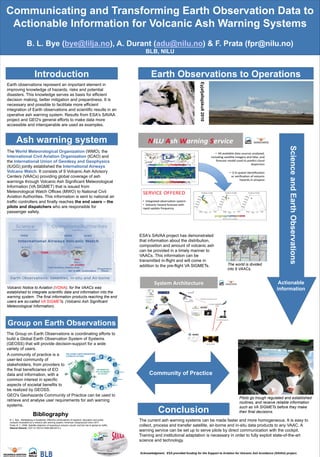
Volcanic Ash Warning System: Communicating and Transforming Earth Observation Data to Actionable Information
- 1. Communicating and Transforming Earth Observation Data to Actionable Information for Volcanic Ash Warning Systems B. L. Bye (bye@lilja.no), A. Durant (adu@nilu.no) & F. Prata (fpr@nilu.no) BLB, NILU Introduction Earth Observations to Operations Eyjafjallajökull 2010 Earth observations represent an important element in improving knowledge of hazards, risks and potential disasters. This knowledge serves as basis for efficient decision making, better mitigation and prepardness. It is necessary and possible to facilitate more efficient integration of Earth observations and scientific results in an operative ash warning system. Results from ESA's SAVAA project and GEO's general efforts to make data more ESA Kristin Vogsfjord accessible and interoperable are used as examples. Ash warning system Science and Earth Observations The World Meteorological Organization (WMO), the International Civil Aviation Organization (ICAO) and the International Union of Geodesy and Geophysics (IUGG) jointly established the International Airways Volcano Watch. It consists of 9 Volcanic Ash Advisory Centers (VAACs) providing global coverage of ash warnings through Volcanic Ash Significant Meteorological Information (VA SIGMET) that is issued from Meteorological Watch Offices (MWO) to National Civil Aviation Authorities. This information is sent to national air traffic controllers and finally reaches the end users – the pilots and dispatchers who are responsible for passenger safety. ESA's SAVAA project has demonstrated that information about the distribution, composition and amount of volcanic ash can be provided in a timely manner to VAACs. This information can be transmitted in-flight and will come in addition to the pre-flight VA SIGMETs. The world is divided into 9 VAACs. Actionable Volcanic Notice to Aviation (VONA), for the VAACs was information established to integrate scientific data and information into the warning system. The final information products reaching the end users are so-called VA SIGMETs. (Volcanic Ash Significant Meteorological Information). Group on Earth Observations The Group on Earth Observations is coordinating efforts to build a Global Earth Observation System of Systems (GEOSS) that will provide decision-support for a wide variety of users. A community of practice is a user-led community of stakeholders, from providers to the final beneficiaries of EO data and information, with a Community of Practice common interest in specific aspects of societal benefits to be realized by GEOSS. Kathrine Roede GEO's Geohazards Community of Practice can be used to Pilots go trough regulated and established retrieve and analyse user requirements for ash warning routines, and receive reliable information systems. Bibliography Conclusion such as VA SIGMETs before they make their final decisions. B. L. Bye, Multitasking in Academia. Effective combinations of research, education and public outreach illustrated by a volcanic ash warning system, American Geophysical Union 2011 The current ash warning systems can be made faster and more homogeneous. It is easy to Prata, A. J., 2008, Satellite detection of hazardous volcanic clouds and the risk to global air traffic, collect, process and transfer satellite, air-borne and in-situ data products to any VAAC. A Natural Hazards, DOI 10.1007/s11069-008-9273-z warning service can be set up to serve pilots by direct communication with the cockpit. Training and institutional adaptation is necessary in order to fully exploit state-of-the-art science and technology. Acknowledgment. ESA provided funding for the Support to Aviation for Volcanic Ash Avoidance (SAVAA) project. www.postersession.com
